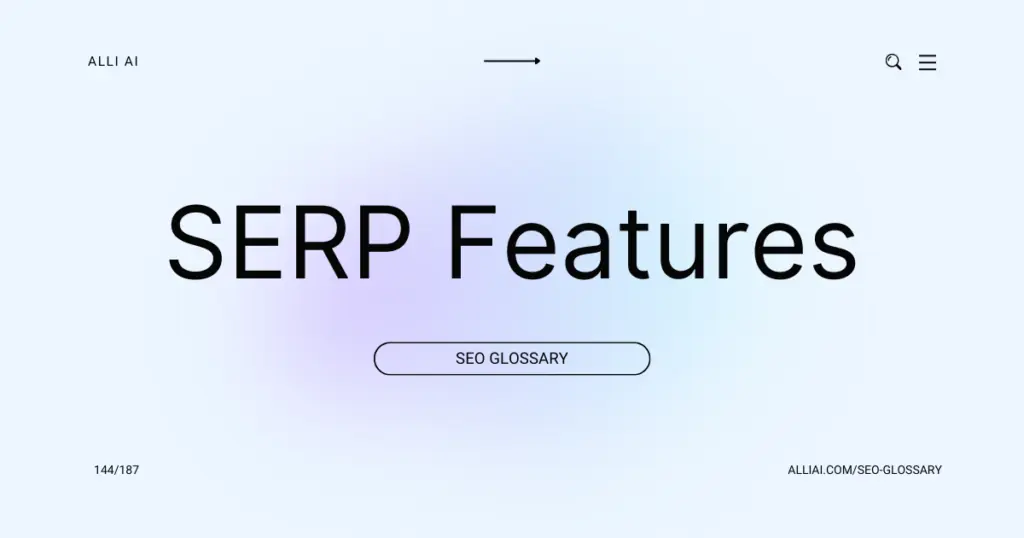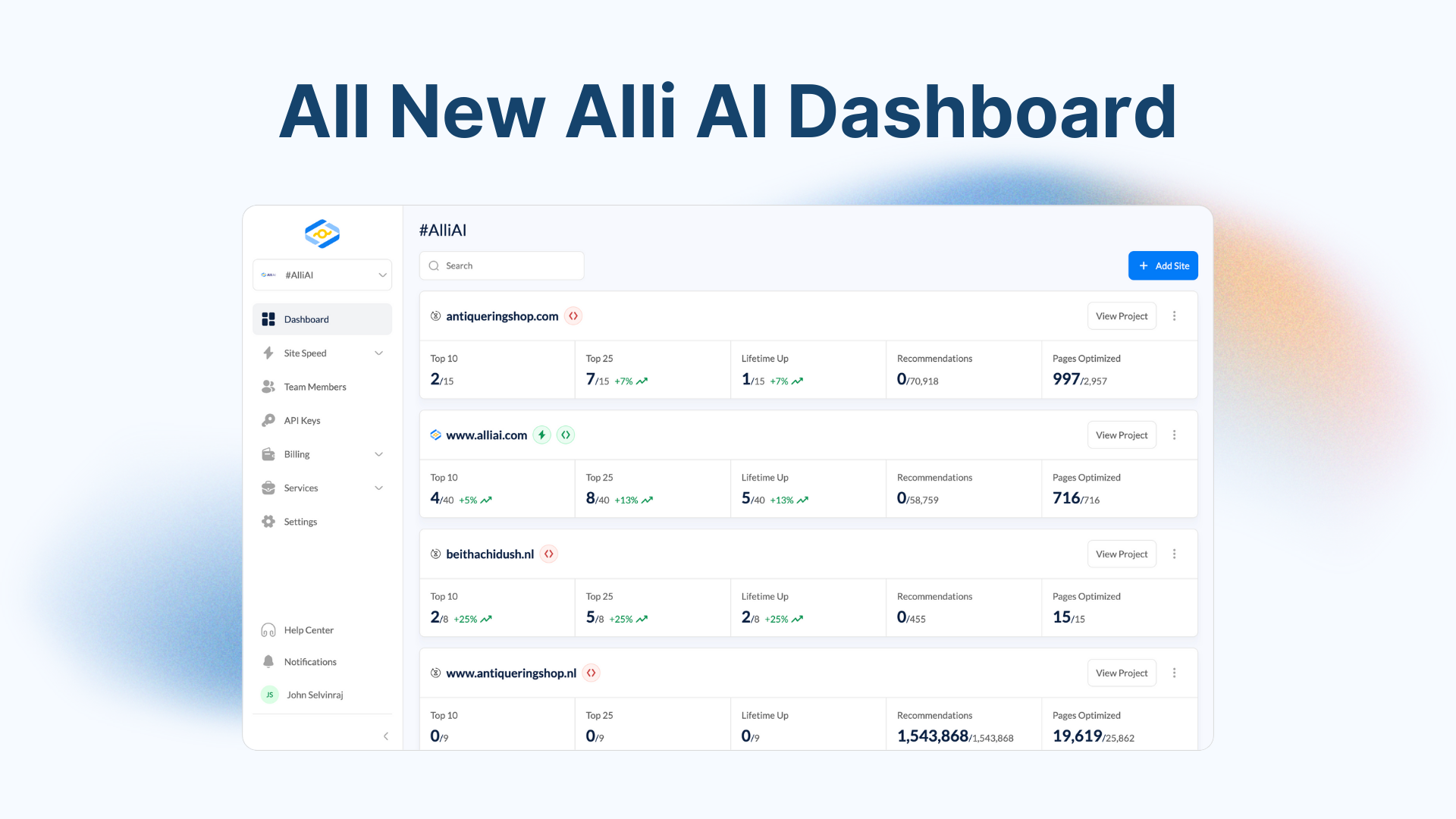What Does SERP Features Mean?
SERP features are special elements and formats that appear on search engine results pages (SERPs) beyond the traditional text-only listings. These features, such as featured snippets, local packs, images, and reviews, are designed to provide users with more direct, varied, and visually engaging information quickly and efficiently. They can help websites to stand out in the search results and potentially drive more traffic.
Where Does SERP Features Fit Into The Broader SEO Landscape?
SERP features are special elements and formats that Google uses to display search results beyond the traditional blue link format. These features include rich snippets, featured snippets, knowledge graphs, local pack listings, and video or image results. In the broader SEO landscape, SERP features play crucial roles in enhancing visibility, improving user experience, and increasing click-through rates, making them essential for SEO strategies that aim to maximize organic search presence and meet specific user needs more effectively. By optimizing for these features, websites can stand out in competitive search queries, capture more targeted traffic, and provide direct answers or information that aligns with the intent behind search queries.
Real Life Analogies or Metaphors to Explain SERP Features
1. Featured Snippets: Imagine walking into a library and instead of browsing through every book for an answer, the librarian hands you a page that summarizes exactly what you need. That’s what Google does with Featured Snippets.
2. Knowledge Graphs: Think of it as a spider web in the corner of a room, connecting various points like family, work, and hobbies about a person or a thing in one visible cluster.
3. Local Pack: Picture a mall directory that points you to all the stores that offer what you’re looking for within the mall. Local Pack does essentially the same by showing you nearby business options.
4. Image Pack: Consider a photo album that pops open as soon as you mention someone’s name, showing you all their pictures; Google’s Image Pack brings up relevant images based on your search query.
5. Top Stories: It’s like tuning into your favorite news channel during a news flash where only the latest and most pressing news items are covered. Top Stories gives you current news related to your query.
6. Site Links: Imagine a treasure map where X marks the spot, but there are also smaller paths drawn out that lead to other specific treasures. Site Links guide users directly to different relevant sections of a website.
7. Shopping Results: Visualize going to a supermarket with a shopping list, and finding a special aisle that only displays everything on your list in one place. Google’s Shopping Results compile product lists based on your search queries.
8. Videos: Think of peering into a shop window and seeing a TV screen showcasing a highlight reel of a product or topic; Google’s Video results operate similarly by giving you relevant video content.
9. People Also Ask: Consider a curious child who constantly asks follow-up questions. Each answer you give leads to another question. “People Also Ask” boxes function as an unfolding sequence of related queries and answers.
10. Twitter Results: Imagine walking into a cafe where people are discussing recent events. Listening in on these conversations gives you real-time updates and opinions; similarly, Twitter results on Google show live commentary from users around the world.
How the SERP Features Functions or is Implemented?
1. Direct Answer (Featured Snippet): Extracts content from a webpage providing a quick, direct answer or definition to a user’s query, displayed at the top of SERPs.
2. Knowledge Graph: Uses entities from Google’s Knowledge Graph, showing information such as facts, figures, and relationships related to queries, often shown to the right of search results or above organic results for broad queries.
3. People Also Ask (PAA): Displays a box of related questions and dropdown answers sourced from various web pages, expanding as questions are clicked to provide more answers relevant to original or tangential queries.
4. Image Pack: Shows a horizontal row of images relevant to the search query, which when clicked, lead to Google Images search for viewing or further interaction.
5. Video Results: Features video content related to the search query. These can be from YouTube or other sources, included in a carousel format.
6. Top Stories: Show news articles from credible sources related to current events prominently, often in a carousel format, includes headlines, source, and sometimes a brief description.
7. Local Pack: Displays local business listings relevant to location-specific queries, showing map, locations, and basic business information like address, ratings, and hours.
8. Shopping Results: Shows product listings related to the query, both paid and organic. Includes prices, brands, reviews, and other relevant product details.
9. Site Links: Sub-links from a domain providing shortcuts to important pages of a site directly in the search results to help users navigate the site directly from SERP.
10. Reviews and Ratings: Aggregates user ratings and reviews often displayed for products, services, recipes, etc., showing an average star rating and review counts.
11. Twitter Results: Shows latest tweets from or related to the searched keywords, integrating real-time information within the search results.
12. Job Listings: Displays job openings relevant to job-related queries, allowing users to see job titles, locations, and some details without visiting another page.
13. AdWords Top and Bottom: Paid advertisements typically positioned both above the organic search results and at the bottom of the page, clearly labeled as “Ad”.
Each of these features requires signal processing from the user’s search query and combines data indexing, retrieval, and ranking methodologies specific to each feature, ensuring relevance and quality of content displayed in SERP features.
Impact SERP Features has on SEO
SERP features significantly impact a website’s SEO performance and user experience by affecting visibility, click-through rates, and traffic. Features such as featured snippets, local packs, and knowledge panels can dominate the first page of search results, reducing the visibility of traditional organic listings. Websites that optimize for these features may experience higher visibility and increased click-through rates compared to those that only focus on standard SEO tactics.
Rankings can also be indirectly affected as higher engagement and click-through rates from SERP features may signal to search engines that a website is a valuable resource, potentially improving its overall search rankings. Moreover, features like rich snippets enhance user experience by providing quick answers, reviews, and other useful information, encouraging higher interaction rates and potentially reducing bounce rates. This improved user experience and user engagement can further contribute to better SEO performance.
SEO Best Practices For SERP Features
1. Featured Snippets:
– Identify common questions related to your topic using tools like AnswerThePublic.
– Structure your content to directly answer these questions concisely.
– Use headers (H2, H3) for the questions and provide answers in the paragraphs immediately following.
– Include lists, tables, or steps to make the data more organized and snippet-friendly.
2. Image Packs:
– Include relevant, high-quality images in your content.
– Use descriptive file names and alt text for each image.
– Optimize image size for quick loading while maintaining quality.
– Consider the context of your images within the content to enhance relevance.
3. Local Pack:
– Verify your business on Google My Business.
– Ensure all business information is accurate and comprehensive, including address, phone number, and business hours.
– Collect and respond to customer reviews.
– Include location-specific keywords in your website’s metadata and content.
4. Reviews:
– Encourage customers to leave reviews on your Google My Business profile and other relevant platforms.
– Respond professionally to both positive and negative reviews.
– Incorporate schema markup for reviews on your product pages to enhance visibility in SERPs.
5. Video:
– Create relevant video content that addresses topics of interest to your target audience.
– Host videos on YouTube and embed them on your website.
– Optimize video titles, descriptions, and tags with target keywords.
– Encourage viewer interaction (likes, comments, shares).
6. Site Links:
– Have a clear and well-structured website hierarchy.
– Use internal linking wisely to emphasize important pages.
– Ensure main navigation is logical and easily navigable.
– Provide a sitemap to Google via Google Search Console.
7. Knowledge Panel:
– Establish your brand/entity on Wikipedia or other relevant databases if applicable.
– Provide consistent information about your brand across the web.
– Utilize structured data markup on your website to help Google recognize and display your entity correctly.
8. People Also Ask (PAA):
– Research PAA boxes for relevant queries and note recurring questions.
– Tailor your content to answer these specific questions comprehensively.
– Include question-based headings in your content and follow with detailed answers.
9. Twitter Boxes:
– Maintain an active Twitter profile linked to your website.
– Regularly tweet content that includes popular and relevant hashtags.
– Engage with users and retweet relevant content to increase visibility.
10. Google Shopping:
– Set up a Google Merchant Center account.
– Upload accurate and comprehensive product data, including titles, descriptions, and images.
– Optimize product titles and descriptions for key search terms.
– Participate in Google Ads for product listings to boost visibility.
By following these steps, you can optimize your content for various SERP features, enhancing visibility and user engagement.
Common Mistakes To Avoid
1. Ignoring SERP Features in Keyword Research:
– Use tools that show SERP features for targeted keywords.
– Analyze the intent behind keywords that trigger specific SERP features.
2. Over-Optimizing for One SERP Feature:
– Balance your SEO strategy across various SERP features rather than focusing solely on one (like featured snippets).
3. Neglecting Structured Data:
– Implement and regularly update structured data to enhance eligibility for rich snippets.
4. Inconsistent NAP Information for Local SEO:
– Ensure Name, Address, and Phone number (NAP) consistency across all online platforms.
5. Not Optimizing for Image and Video Search:
– Use descriptive, keyword-rich file names and alt tags for images.
– Optimize video titles, descriptions, and tags and consider hosting on multiple platforms.
6. Poor Mobile Optimization:
– Use responsive design and test website performance on various devices and screen sizes.
7. Not Tracking Changes in SERP Layouts and Features:
– Regularly monitor SERPs for changes and adjust strategies accordingly.
8. Focusing Solely on Organic Positions Ignoring Zero-Click Searches:
– Optimize for features that cater to zero-click searches like featured snippets, knowledge panels.
9. Misjudging the Impact of Ads on Click-Through Rates:
– Analyze the positioning and frequency of ads for your key terms and adjust your SEO strategy to adapt.
10. Overlooking the Impact of Social Media Profiles in SERPs:
– Maintain active and optimized social media profiles to increase visibility in SERPs.
11. Ignoring Voice Search and Question-Based Queries:
– Incorporate question-based content and long-tail keywords optimized for natural language processing.






